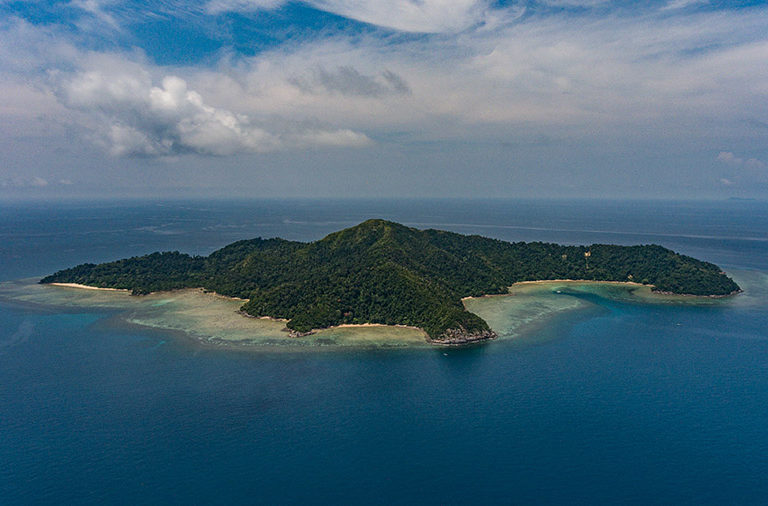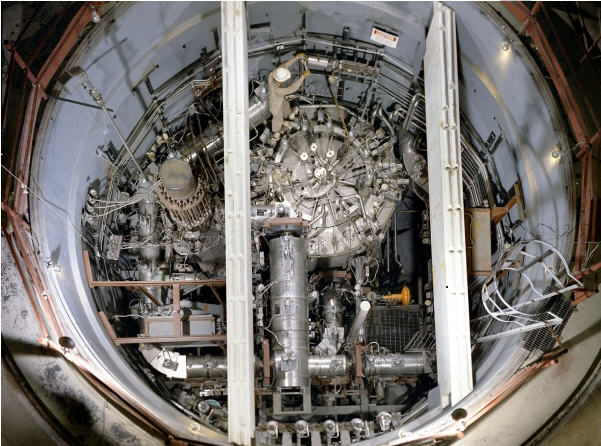- PT ThorCon Power Indonesia is moving closer toward building an experimental nuclear reactor on a remote island in a strait bisecting the islands of Sumatra and Borneo.
- The company says the electricity generated by a thorium-powered reactor could generate electricity at 3 cents per kilowatt hour while emitting close to zero greenhouse gases.
- Some worry the project could threaten delicate marine ecosystems on an island that was, until recently, protected as a conservation area.
PALEMBANG, Indonesia — In February 1965, President Sukarno, flanked by aides and a photographer, unlocked the door to Indonesia’s first experimental nuclear reactor, the TRIGA Mark II, in the city of Bandung. Six decades later, the world’s fourth-largest country has yet to open a nuclear power station.
However, on a remote island of Indonesia in a challenging strait, a little-known company is hoping to spark change using a frontier nuclear technology.
In March this year, PT Thorcon Power Indonesia announced it had signed an agreement with Indonesia’s nuclear regulator to begin “safety, security, and safeguards consultation in preparation for licensing the 500 MW demonstration nuclear power plant” on Gelasa Island in Bangka-Belitung province.
The Indonesia entity is a subsidiary of the Singapore-based power firm ThorCon International, Pte. Ltd. The company’s reactor design is a scaled version of a molten-salt reactor, the subject of an experiment at the Oak Ridge National Laboratory in the U.S. state of Tennessee during the 1960s. ThorCon claims the electricity generated by a realized project would cost 3 cents per kilowatt hour (in 2021 coal generation in Indonesia cost more than 4 cents per kilowatt hour).
If the Gelasa Island facility is built, ThorCon’s power plant could diversify Indonesia’s grid with a new energy technology generating no direct carbon emissions — in 2022, Indonesia hiked its commitment to cut greenhouse gas emissions to 31.8% by 2030, with most of the reduction to come from land use.
“This consultation agreement is a major milestone that indicates that the Indonesian Government is serious about providing the efficient regulation required to allow for the licensing of nuclear power in a timely and economic manner,” ThorCon said in a statement.
However, environmental activists and researchers in Bangka-Belitung worry that the development could spur new environmental challenges in a region of Indonesia devastated by tin mining for more than two decades.
“My guess is the release of carbon from the sea,” said M. Rizza Muftiadi, who researches marine biology at Bangka Belitung University.

Atomic theory
Thorium has been advanced as a potential power source since the early days of civil nuclear engineering in the 1950s. While nuclear fuels like plutonium and uranium are scarce, thorium is an element found in the Earth’s crust — and is a common byproduct of Indonesia’s messy mining operations.
“Thorium is three times more abundant in nature compared to uranium,” according to the International Atomic Energy Agency in a 2005 report on thorium.
Advocates of thorium-derived power cite an array of benefits, from less-hazardous waste to reduced potential of thorium in nuclear weaponry.
Nuclear development in Indonesia began in 1954 after Sukarno, the country’s first post-independence president, enacted a State Committee for Investigation of Radioactivity.
A series of incremental developments took place over the following decades, including Sukarno’s 1965 unveiling of the TRIGA Mark II and construction of a research reactor in Serpong, Banten province, in 1987.
Arguments in favor of nuclear power for Indonesia included diversification of the grid and opportunities for research and development.
The scientist who oversaw development of the TRIGA Mark II, National Nuclear Energy Agency head Djali Ahimsa, wrote a business-case paper in the late 1980s saying “economic studies to date indicate that nuclear energy could be part of Indonesia’s energy mix before the end of the century.”
More than two decades into the new century, nuclear power remains absent on Indonesia’s coal-heavy electricity grid, but ThorCon’s engineers remain hopeful.
In 2021, ThorCon appointed an engineering contractor to build the 500 MW plant in Indonesia, and in February 2022, the company inked a memorandum of understanding with Indonesia’s National Research and Innovation Agency to develop the reactor technology.
However, some in Indonesia doubt the project can be realized as a going concern .
“Around the world, thorium power plants have never operated on a commercial scale,” said Eko Bagus Sholihin, a researcher at Raden Fatah State Islamic University and author of a book on Bangka-Belitung’s environment.

Strait talking
The island of Gelasa sits in the Gaspar Strait, a treacherous stretch of water named after a Spanish captain who sailed through the strait on the way to the Philippines in 1724. Today the tiny island of Gelasa, measuring less than 3 kilometers (1.9 miles) across, is known to few, except that it may one day be the site of Indonesia’s nuclear power station.
Gradual progress toward realizing Indonesia’s first nuclear power plant on Gelasa is worrying some researchers and environmentalists, who say the island’s conservation value is at stake.
Environmental activists and researchers in Bangka-Belitung caution that the plant could cause environmental harms that are poorly understood at present.
Rizza, the marine biologist, said that while the energy generated by a thorium-powered molten-salt reactor will generate fewer carbon emissions, the development required around the plant poses risks to turtles, dolphins, stingrays and other marine species around the island.
Research and a survey of Gelasa Island conducted by the University of Bangka Belitung together with Mongabay Indonesia and the Indonesian Forum for For the Environment, a civil society group, found mangrove forests covering around 2.5 hectares (6.1 acres) as well as 126 hectares (311 acres) of coral reefs around the island. Vast Anacropora spinosa coral — measuring between 5 and 11 meters (16 and 36 feet) in diameter — were found near the shore.

“This is most likely an ancient coral reef,” Rizza said.
A wide diversity of other marine life exists in this habitat, from dugongs and sea cucumbers to manta rays and octopi.
“This means that Gelasa Island and its waters have high conservation value,” Rizza said. “Gelasa Island and its waters should be designated as a conservation area.
Despite the apparent conservation value around Gelasa, the island’s protection status has changed in recent years.
A spatial plan published by the district government showed in 2014 that Gelasa Island held conservation area status, preventing any development. A separate spatial plan in 2019 showed the island classified as a nature reserve. In 2020, the waters off Gelasa were classed as a tourism zone. Then in 2023, the Island was officially designated as the location for a thorium power plant.
Shortly after that decision was announced, the director of PT ThorCon Power Indonesia, Bob S. Effendi, said the company would conduct environmental impact assessments and spatial plans. The company had studied the environment around Gelasa for the last year, Effendi said, adding that he was encouraged by the early results.
“This is a first and concrete step,” Effendi said.
Banner image: Nautilus pompilius shell found around Teluk Pisang, Gelasa Island. Image by Nopri Ismi for Mongabay Indonesia.
This story was reported by Mongabay’s Indonesia team and first published here on our Indonesian site on June 26, 2023.
In a country long wary of nuclear, an Indonesian chases the thorium dream
Citation:
Thorium fuel cycle — Potential benefits and challenges. (2005). Retrieved from International Atomic Energy Agency website: https://www-pub.iaea.org/mtcd/publications/pdf/te_1450_web.pdf
FEEDBACK: Use this form to send a message to the author of this post. If you want to post a public comment, you can do that at the bottom of the page.
